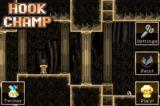2010 IGF finalist, Hook Champ swings with challenging performative platforming. Despite limited scope, it's charming!
Challenging Performative Play: swing physics are strong, impressive platforming and level-design, gameplay is well orchastrated
Rewards play with good variety: Multiple "worlds" to beat, loot to grab, equipment to level, clothes to wear, characters to play (including Minigore)
Somewhat limited: later worlds are very hard which can be a killer, environments vary but overall aesthetic does not, exploration limited by strict time constraints (chasing demon)
- - - - -
Developed by Rocketcat Games, Hook Champ was a 2010 IGF Mobile finalist, and has become one of the few games to garner a decent amount of attention from game enthusiasts on the iphone. As it's sequel, Hook Worlds, is approaching its release date, it's a good time to visit the original.
In Hook Champ, you play a sort of swinging Indiana Jones who's mission it is to grab 20 Idols from 5 different main locations (plus extra unlockable content). While grappling hook games have started to aggregate, Hook Champ was one of the first over a year ago and remains one of the best in its field. With rope and grappling hook in toe, at the beginning of each level in Hook Champ, you grab a sacred idol which wakes an angry demon who proceeds to chase you though to the end where you're finally rescued. To get from start to finish, however, you'll need to use your platforming skills to traverse the dangerous distances and avoid being eaten. While it's possible to walk in places, your primary movement will consist of swinging from ledge to ledge, grabbing coins as you go (used to level and buy new equipment), to escape. The swing physics are strong, which make learning to swing easy but mastering the skill quite challenging.
Each of the 5 original "worlds" tend to partake of rather standard platforming tropes, like a lava level and water level, though for the most part the swing mechanic keeps things from falling into trope. At any time you can play in any unlocked world, so if you get stuck somewhere you have the opportunity to go elsewhere, build up your cash reserves for upgrades and try again later. And try again you will. Death is frequent in Hook Champ, though thankfully you keep all the coins you collect before you die, which retains purpose for play despite your many deaths. You'll also see your best past self as a ghost when you play, so you can compare yourself while you play, though this option can be distracting and is able to be turned off.
Certainly, the performative play is bolstered by the shop, where you can buy everything from guns (to ward off the demon) to leaping shoes (to reach the heights) to upgraded hooks and ropes and fancy clothes to outfit your guy. This isn't a mindblowing addition to the core gameplay, but it does keep things moving and gives you a reason to keep playing even when you're making little progress. Many items are unlocked as you play, as are additional playable characters (like Minigore from the IP hit Minigore), and additional worlds which are extremely difficult.
Where Hook Champ falters is in it's primary focus on performance and speed. The levels invite curiosity and exploration, but with a demon chasing you you're priority is always on escape. There are hints of aesthetically rich worlds to see, but too often you'll simply play through standard cave-like settings. There's also no soundtrack to speak of, and so potentially memorable moments are purely visual. Hook Champ would've done better to encourage discovery and nix the shop altogether, perhaps by allowing for item upgrades within caves, or including some caves in which no demon was out to get you; in other words, by mixing it up and leaving the well-worn shop behind.
Yet you'll likely forgive Hook Champ its shortcomings because of it's excellent platforming and charm. It never takes itself too seriously and you'll learn how to escape with each idol after lots of practice and new upgraded gear. It's got just the right difficulty curve to keep you playing and a minimal aesthetic to draw you in. It won't stay with you long after you play, but it's a good game that helped to solidify the place of the grappling mechanic in platformers and is worth the price of admission.
7.9/10

